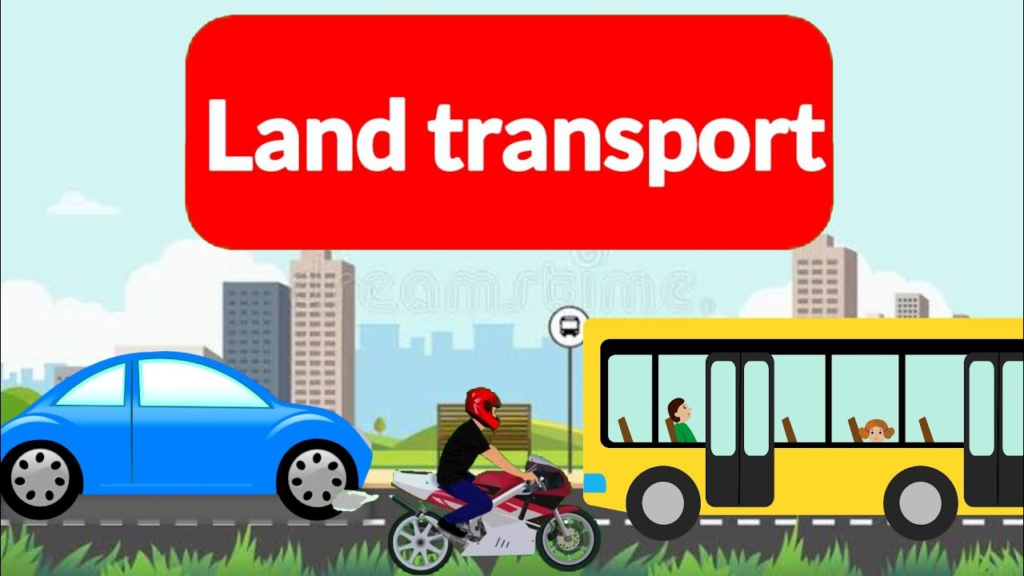Land Transportation Associate (1 years diploma)
Land Transportation Associate click here
Brief Job Description: The role holder is responsible for overall vehicle
movement and ground operations. The individual receives order details,
processes mandatory documents, conducts route survey, coordinates with
supervisor for loader requirement and garage supervisor for fleet maintenance,
arranges for consignment pick-up, issues In-Gate and Gate Exit pass and monitor
and updates status of each consignment.

Qualifications Pack for Land Transportation Associate
Options
Option 1: Transport Consolidation
The unit is about undertaking transport consolidation activities in a warehouse or
loading hub
Option 2: Customs Clearance
The unit is about meeting customs inspection requirements such as packaging,
scanning, loading and transport arrangement
Personal Attributes: The individual should be self-starter, eye for details, good
analytical skills and ability to work with varied stakeholders. S/he should be
observant, diligent, have basic mathematical ability. S/he should communicate
effectively in vernacular language.
Description
Core Skills/Generic
Skills
Core Skills or Generic Skills are a group of skills that are key to learning and
working in today’s world. These skills are typically needed in any work
environment. In the context of the NOS, these include communication related
skills that are applicable to most job roles.
Function
Function is an activity necessary for achieving the key purpose of the sector,
occupation, or area of work, which can be carried out by a person or a group
of persons. Functions are identified through functional analysis and form the
basis of NOS.
Job role Job role defines a unique set of functions that together form a unique
employment opportunity in an organization.
Knowledge and Understanding
Knowledge ing are statements which together specify the technical, generic,
professional and organizational specific knowledge that an individual needs in
order to perform to the required standard.
National Occupational
Standards (NOS) NOS are Occupational Standards which apply uniquely in the Indian context
Occupation Occupation is a set of job roles, which perform similar/related set of functions
in an industry.
Organisational Context
Organisational Context includes the way the organization is structured and
how it operates, including the extent of operative knowledge managers have
of their relevant areas of responsibility.
Performance Criteria Performance Criteria are statements that together specify the standard of
performance required when carrying out a task.
Qualifications
Pack(QP)
Qualifications Pack comprises the set of NOS, together with the educational,
training and other criteria required to perform a job role. A Qualifications
Pack is assigned a unique qualification pack code.
Electives Electives are NOS/set of NOS that are identified by the sector as contributive
to specialization in a job role. There may be multiple electives within a QP for
each specialized job role. Trainees must select at least one elective for the
successful completion of a QP with Electives.
Options Options are NOS/set of NOS that are identified by the sector as additional
skills. There may be multiple options within a QP. It is not mandatory to select
any of the options to complete a QP with Options.
Unit Code Unit code is a unique identifier for an Occupational Standard, which is
denoted by an ‘N’
Unit Title Unit title gives a clear overall statement about what the incumbent should be
able to do.
Qualifications Pack
Code
Qualifications Pack Code is a unique reference code that identifies a
qualifications pack.
Scope
Scope is the set of statements specifying the range of variables that an
individual may have to deal with in carrying out the function which have a
critical impact on the quality of performance required.
Sector Sector is a conglomeration of different business operations having similar
businesses and interests. It may also be defined as a distinct subset of the
economy whose components share similar characteristics and interests.
Sub-Sector Sub-sector is derived from a further breakdown based on the characteristics
and interests of its components.
Sub-functions Sub-functions are sub-activities essential to fulfil the achieving the objectives
of the function.
Technical Knowledge Technical Knowledge is the specific knowledge needed to accomplish specific
designated responsibilities.
Description
5S Sort, Set In order, Shine, Standardize and Sustain
CGST Central Goods and Services Tax
DC Delivery Challan
EDO Equipment Delivery Order
ERP Enterprise Resource Planning
EXIM Export-Import
FTL Full Truck Load
GPS Global Positioning System
GST Goods and Services Tax
GSTIN GST Identification Number
HR Human Resources
HSN Harmonized System Nomenclature
IGST Integrated Goods and Services Tax
LTL Less than Truck Load
LR Lorry Receipt
MHE Material Handling Equipment
MIS Management Information System
NSQF National Skills Qualifications Framework
OH&S Occupational Health and Safety
OS Occupational Standards
OSHA Occupational Safety and Health Administration
PAN Permanent account number
PO Purchase order
PPE Personal Protective Equipment
QP Qualifications Pack
SAC Service accounting code
SOP Standard Operating Procedure
SGST State Goods and Services Tax
TMS Transport Management System
UIN Unique identification number
Book and process consignments

Description This unit is about obtaining, preparing and updating consignment booking details
Scope This unit/task covers the following:
• Receive order details from customers and plan for vehicle
• Process mandatory documents
Range: SOP, Stationery, markers, PPEs, Enterprise Resource Planning (ERP)/ Transport
Management System (TMS) software, computer, printers, GPS tracker etc.
Performance Criteria(PC) w.r.t. the Scope
Element Performance Criteria
Receive order details
from customers and
plan for vehicle
To be competent, the user/ individual on the job must be able to:
PC1. obtain order requirement from customer through email or telephone calls
PC2. determine the type of vehicle required and check for loading arrangements in
the vehicle based on the nature of the goods, space required, etc. and update
details in system
PC3. finalise the loading of goods to be a part of Full Truck Load (FTL) or Less than
Truck Load (LTL) based on goods type and client’s requirement
PC4. find out the market rates depending on the destination and the load for a
competitive pricing
PC5. suggest to transport the goods using company’s fleet or to tie up with other
transporters
PC6. post confirmation of order by the customer, print proforma invoices with
consignment details and communicate the same
Process mandatory
documents
To be competent, the user/ individual on the job must be able to:
PC7. check if the vehicle meets the regulatory requirement in terms of width,
height and length of the vehicle with respect to number of axles
PC8. fill Lorry Receipt (LR), hand over one copy to the customer, one copy to the
truck driver and retain copy for records
PC9. prepare transit insurance forms and Goods and Services Tax (GST) permits for
dispatching vehicles and agreement sheet to be given at destination along
with consignment
PC10. check papers like road permit are available with the transporter and
coordinate with the customer
PC11. facilitate advance payment to transporter as per agreement
PC12. update periodically in the system till dispatch of goods if there are any
changes in the quantity, packaging, destination etc.
PC13. update information on vehicle movement for ease of tracking
PC14. on delivery of goods and receipt of acknowledgement, close the order in the
system and raise invoice
PC15. receive the signed agreement sheet and inbound documentation from the
incoming transport and fill all the required forms for inbound transports
Knowledge and understanding
Organizational Context (Knowledge of the company /organization and its processes)
The individual on the job needs to know :
KA1. organizational procedures
KA2. company’s customer accounts
KA3. organization fee and charges structure
KA4. types of documentation in organization
KA5. organization policy of data maintenance, recording and handling
KA6. relevant safety and security procedures
KA7. different transport companies the organization works with and their
processes
KA8. procedure followed while booking trucks to pick up and transport
consignments
B. Technical Knowledge
The individual on the job needs to know :
KB1. processes involved in inbound and outbound transport
KB2. use of computer for electronic documentation of information
KB3. different geographies and distances to different destination
KB4. functioning of ERP systems and their operations
KB5. possible difficulties in booking customer orders
KB6. possible common challenges and solutions for booking orders (delays, low
capacity utilization etc.)
Skills (S)
A. Core Skills/
Generic Skills
Reading Skills
The user/individual on the job needs to know how to read:
SA1. schedule and plan for cargo transport
SA2. an instruction in the checklists, order lists etc.
SA3. instructions from email queries/ written queries/ work orders
Writing Skills
The user/individual on the job needs to know how to:
SA4. respond to email/ written queries of customers
SA5. fill forms related to customer consignments
SA6. maintain the record as per company’s policies
Oral Communication (Listening and Speaking skills)
The user/individual on the job needs to know how to:
SA7. communicate clearly with managers, peers and other staff at the hub/station
SA8. communicate with reporting officer and contractual workers to ensure
activities are running smoothly
SA9. follow up on trucking companies and customers
B. Professional Skills Decision Making
The user/individual on the job needs to know how to:
SB1. make a judgment as to whether a customer order can be taken up or needs to
be dropped
SB2. make an estimate of the associated costs with respect to the transport order
Plan and Organize
The user/individual on the job needs to know how to:
SB3. prioritize and execute tasks in within the scheduled time limits
SB4. maintain schedules and punctuality
Customer Centricity
The user/individual on the job needs to know how to:
SB5. attend customer requirements and update the same in ERP
Problem Solving
The user/individual on the job needs to know how to:
SB6. identify and correct errors in documents
SB7. handle day to day problems like delays, staffing shortage, etc.

Analytical Thinking
The user/individual on the job needs to know how to:
SB8. organise the documents with attention to detail
SB9. estimate the price to be billed to the customer for transporting the
consignment to a destination
SB10. assess the type of truck required and whether FTL or LTL is to be used
Critical Thinking
The user/individual on the job needs to know how to:
SB11. concentrate on task at hand and complete it without errors
Route planning and vendor coordination
Description This unit is about conducting route survey, preparing route plan and coordinating with
vendors
Scope This unit/task covers the following:
• Collect primary data and route planning
• Coordinate with internal and external stakeholders
Range: SOP, computer, ERP/ TMS, worksheets, Route optimization software, MS Excel
and Access, Atlas Map, etc.
Performance Criteria(PC) w.r.t. the Scope
Element Performance Criteria
Collect primary data
and route planning
To be competent, the user/individual on the job must be able to
PC1. collect details on point of origin, point of destination, type of goods, pickup
date and time, delivery date and time, volume of goods, vehicle capacity,
vehicle traffic constraint and transporter details
PC2. calculate the pickup and delivery sequence for optimal time, allocation of
loads, vehicle capacity by entering the details in route planning software
PC3. plan optimised routes for multiple depots ensuring cost efficiency across the
whole operation
PC4. identify the various tolls, rest stops, driver shift change, vehicle relay, refueling of vehicle etc.
PC5. plan daily truck coverage, driver and trip assignment
PC6. communicate route information with staff
PC7. identify alternate routes to maintain service standards in case of contingency
reqirements like inclement weather, natural calamities etc.
PC8. communicate to the customer on the finalised route plan
Coordinate with internal and external stakeholders
To be competent, the user/ individual must be able to:
PC9. coordinate with other internal departments regarding the route plan for
consignment schedule
PC10. make necessary arrangements for consignment pickup/ delivery with the
assigned vehicle driver or transporter
PC11. ensure the assigned vehicle is in good condition to operate as per the planned
schedule, if not coordinate with maintenance department or transporter
PC12. coordinate with transportation supervisor for required drivers and cleaners
allocation for the planned schedule
Knowledge and understanding (K)
A. Organizational
Context
(Knowledge of the
company /
organization and its processes)
The individual on the job needs to know :
KA1. organizational procedures
KA2. documentation and reporting as per organization’s mandate
KA3. security procedures to be followed
KA4. escalation matrix for reporting identified problems
KA5. risk and impact of not following defined procedures/work instructions
Technical Knowledge
The individual on the job needs to know:
KB1. use of computer and associated equipment like scanner
KB2. geographical spread of states and cities
KB3. planning w.r.t routes and network

KB4. types of goods being handled
KB5. federal and state laws pertaining to transportation
KB6. route optimization software
KB7. loading/unloading and transports that can be used for different types of
shipments
KB8. different cargo arrangements to maximize space utilization
Skills (S)
A. Core Skills/
Generic Skills
Reading Skills
The user/individual on the job needs to know how to read:
SA1. written instructions
SA2. route network
Writing Skills
The user/individual on the job needs to know how to:
SA3. write shipment details in the software
SA4. write report regarding damages, mismatch, etc
Oral Communication (Listening and Speaking skills)
The user/individual on the job needs to know how to:
SA5. communicate clearly in local language with team members and vendors
SA6. provide guidance to peers & juniors
SA7. communicate with workers for delays and updates in schedules
B. Professional Skills Decision Making
The user/individual on the job needs to know how to:
SB1. identify the space required for loading and unloading based on shipment and
trucking details
SB2. identify the optimal route for efficient fleet utilization
Plan and Organize
The user/individual on the job needs to know how to:
SB3. estimate time required for each activity and make realistic plans
SB4. maintain schedules and punctuality
SB5. prioritize and execute tasks within the scheduled time limits
SB6. flexibility to re-assess schedule in case of delays/additional orders
Customer Centricity
The user/individual on the job needs to know:
SB7. importance of customer timelines
Problem Solving
The user/individual on the job needs to know how to:
SB8. identify trends/common causes for errors and suggest possible solutions to
the supervisor
SB9. handle day to day problems like delays, staffing shortage, etc.

Analytical Thinking
The user/individual on the job needs to know how to:
SB10. suggest methods to minimise errors
Critical Thinking
The user/individual on the job needs to know how to:
SB11. analyse breakdown to determine most cost effective and timely course of
action
Undertake gate operations
Description This unit is about performing Gate in and Gate out activities
Scope This unit/task covers the following:
• Issue gate entry pass
• Issue gate exit pass
Range: SOP, ERM/ TMS, computer, stationery, projector, etc.
Performance Criteria(PC) w.r.t. the Scope
Element Performance Criteria
Issue gate entry pass
To be competent, the user/individual on the job must be able to:
PC1. based on daily plan for loading or unloading assign the timing for loading/
unloading for the vehicle
PC2. plan for the bay based on priority and type of goods to be loaded/ unloaded
to get the internal approval on the availability of bay
PC3. create entry in the Enterprise Resource Planning (ERP)/ Transport
Management System (TMS) based on the planned bay and timing of the
vehicle
PC4. communicate the same to the transporter or internal department for their
vehicle planning
PC5. collect details about vehicle, driver, vehicle registration number, vehicle
insurance number, container number, release container PIN, equipment
delivery order (EDO), goods to be loaded/ unloaded, Delivery Challan (DC) to
prepare the entry pass
PC6. obtain vehicle permit from the transporter to carry non-normative goods in
case of oversized cargo, Dangerous Goods Declaration/ Certificate in case of
hazardous material
PC7. communicate the collected details to the gate supervisor
PC8. coordinate with the security to instruct the driver on the bay number
Issue gate exit pass
To be competent, the user/individual on the job must be able to:
PC9. verify vehicle registration number, container number, container seal number,
contents of the vehicle, goods insurance etc. against the DC
PC10. ensure that customs verification procedures are completed, and the
goods/containers are sealed, if required
PC11. enter the vehicle details, loaded goods information and other information in
ERP to generate gate exit pass
PC12. communicate the gate exit pass details to security through ERP/TMS
PC13. check that all containers are gated out after completion of necessary customs
and legal procedures against gate entry
Knowledge and understanding
Organizational context (Knowledge of the company / organization and its processes)
The individual on the job needs to know:
KA1. organizational procedures
KA2. different freight forwarding companies
KA3. documentation and reporting as per organization’s mandate
KA4. security procedures to be followed
KA5. escalation matrix for reporting identified problems
KA6. risk and impact of not following defined procedures/work instructions

B. Technical knowledge
The individual on the job needs to know:
KB1. use of computer and associated equipment like scanner
KB2. various documents for export and import
KB3. special documents for dangerous and hazardous goods
KB4. different types of goods being handled
KB5. special characteristics and handling requirements of goods
Skills (S)
A. Core Skills/
Generic Skills
Reading Skills
The user/individual on the job needs to know how to read:
SA1. written instructions
SA2. documents
SA3. management directions in English
Writing Skills
The user/individual on the job needs to know how to:
SA4. write details of the documents in the systems
SA5. write report regarding damages, mismatch, etc
SA6. write and issue Gate-In and Gate-Exit pass
Oral Communication (Listening and Speaking skills)
The user/individual on the job needs to know how to:
SA7. communicate clearly in local language or English with team members and
drivers, warehouse supervisors
B. Professional Skills Decision Making
The user/individual on the job needs to know how to:
SB1. decide on action to be taken for missing documents
SB2. decide on alloting bay to the driver
Plan and Organize
The user/individual on the job needs to know how to
SB3. organize documents for easy assessment and inspection
Customer Centricity
The user/individual on the job needs to know :
SB4. importance of customer timelines
Problem Solving
The user/individual on the job needs to know how to:
SB5. identify trends/common causes for errors and suggest possible solutions to
the supervisor
Analytical Thinking
The user/individual on the job needs to know how to:
SB6. suggest and implement methods to optimise utilization of free bay
Critical Thinking
The user/individual on the job needs to know how to:
SB7. focus on task at hand and complete it without errors and delays







